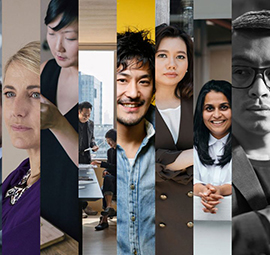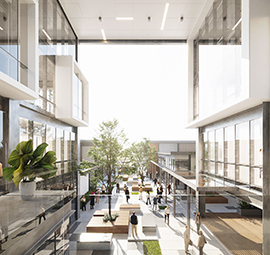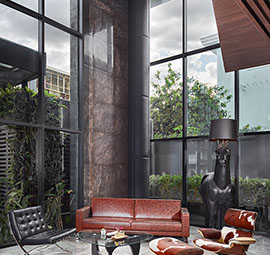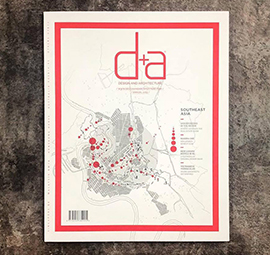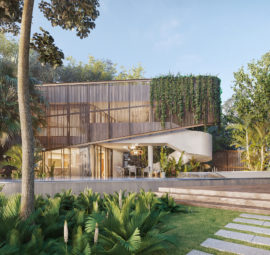
FORWARD CAMBODIA
Architect Hun Chansan is the founder of the well-known architectural and design company RE-EDGE, where his team has slowly been changing the Phnom Penh landscape with their designs. As a leader in the architectural world as well as a lecturer of architecture at some universities, he recently gained public attention after being named as the Property Guru Real Estate Personality of the Year.
Before RE-EDGE
Cambodian born, Chansan was a former student of Bak Tuk primary and secondary school before he was sent to continue his education for 5 years in Singapore. After finishing high school, he decided to pursue degree in architecture in the United States. Less than a decade later, he received his bachelor degree in Architecture from Massachusetts College of Art & Design. He then got Master Degree from Northeast University in Boston before coming back to Cambodia in 2009.
Chansan returned to Cambodia and started his job as a lecturer and coordinator at Limkokwing University. In 2011, he left the University and started to form RE-EDGE and his team.
While abroad, Chansan admitted that he considered if he should stay in America. During that time, Cambodia was slowly recovering from the war with small businesses, while Boston was booming with opportunity. Specialized sectors of aerospace, art, and other professions were at his fingertips, options that were almost non-existent in Cambodia. At the times, the environment in Boston was full of innovation, growth, and diversity — things that suited his talent and passion in the quest to make a name for himself as an architect. An additional lure for him to stay, was his young Cambodian American wife. To make the matters worse, he was the only son in the family. Overcomed with his responsibilities in continuing the legacy of the family business in Cambodia, he had to return. Expecting to live in Cambodia a short time, he was surprised to find a potential market and many opportunities in the country.
Achievements
In the beginning, Chansan struggled to put his talents architectural skills into action in a country which had barely anything to start from. However, he managed to observed a few factors to put him on the right track for success. The key factors are the client’s demand, local materials, feasibility of building, price of materials, quality of building, ability of construction workers, environment, climate, sunlight, fresh air and more. Through those elements, he managed to plan his strategy accordingly and become the man he is today.
After 6 years of hard work, Chansan felt he had proven his worth through his liveliness, a reference to the stunning view of buildings complementing one another. The everchanging sunlight flickering off the reflection of buildings help to produce the feelings of the city becoming alive. Chansan notes that this connection between people, their surrounding environment and the design of building can offer a relaxing and calm atmosphere.
The Competitive Market
Being architect is not just knowing how to draw or sketch the building, says Chansan, but must also consider many things. In order to produce a good piece of work, architects need to understand other relevant things such as art, science, technology, writing, and communication.
Competition for architectural projects are complicated due to the amount of consideration before a plan becomes a reality. According to Chansan, the average time spent in designing each project is around 7-8 months with an additional 2-3 years length of construction — totalling 3 to 4 years before a project is completed. The long progress of each project is why most famous architects are successful in the old age. Fortunately, Chansan has been able to enjoy his notoriety in a short period of time.
Commercial infrastructures are a type of buildings that have been in high demand recently. Most of clients want quick results, but architects face a difficult task in balancing effectiveness and efficiency. Chansan fears that when many in his profession are forced to complete a project promptly, shortcuts are made which can undermine the value of product or particular construction.
Chansan claimed that he has never expected success early in his life. He wanted to focus on his goals that include helping others to get a better life and supporting the development of Cambodia’s society as whole. He thinks that going forward with clear goals and purpose as a team, will yield good things together. To be successful, he added, it doesn’t mean to be imbedded with a fixed principle all the time but to understand situation and design strategies accordingly. He encourages confronting mistakes in being opened to learn new things no matter the status.
Vision for Phnom Penh City
Being positive is important towards the development of Phnom Penh, says Chansan. That energy can be transformed into a better city with a real identity. “If we talk about a certain city, we tend to imagine the symbol of that city,” Chansan explained. “Singapore, for example, has Orchard road which is always recognized. When we talk about New York, we may think of Central Park, but for Phnom Penh, we may think of riverside in front of the Royal Palace.”
Determined to provide more opportunities for the next generation, the silver-haired architect is collaborating with Cambodia’s universities in creation of an institute which will train students architectural skills to build a better city. He has seen many young architects already trying to push the sector forward and is united with them in conserving the value of Khmer identity now and for the future.
“I think there are many other places that make visitors to remember our city,” Chansan added. Citing areas such as Beung Keng Kong could be developed into business district zone with garden, trees, walking streets, restaurants, coffee shops, and art — which he hopes one day will become a reality in Phnom Penh’s future.
Our Design Director is featured in FORWARD Lifestyle, Hun Chansan: The Distinguish Architect in Modern Cambodia.

